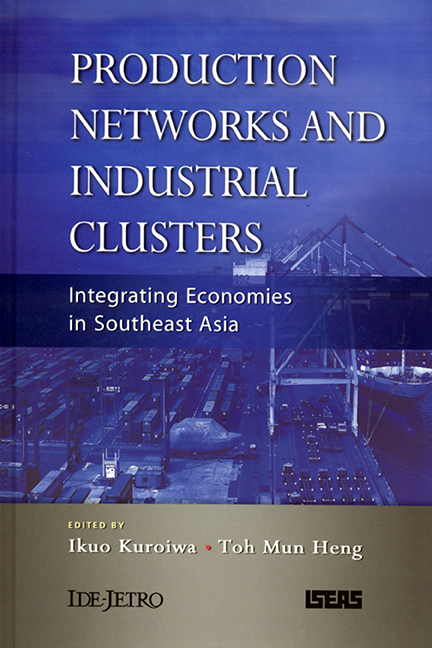Book contents
- Frontmatter
- Contents
- List of Tables
- List of Figures
- Preface
- Acknowledgements
- Contributors
- 1 Introduction
- I Overview of the Production Networks and Industrial Clusters in Southeast Asia
- 2 The Mechanics of Production Networks in Southeast Asia: The Fragmentation Theory Approach
- 3 Cross-Border Production Networks in Southeast Asia: Application of the International Input-Output Analysis
- 4 Industrial Clusters and Production Networks in Southeast Asia: Global Production Network Approach
- II Case Studies
- III Drivers for the Expanding Production Networks
- Index
4 - Industrial Clusters and Production Networks in Southeast Asia: Global Production Network Approach
from I - Overview of the Production Networks and Industrial Clusters in Southeast Asia
Published online by Cambridge University Press: 21 October 2015
- Frontmatter
- Contents
- List of Tables
- List of Figures
- Preface
- Acknowledgements
- Contributors
- 1 Introduction
- I Overview of the Production Networks and Industrial Clusters in Southeast Asia
- 2 The Mechanics of Production Networks in Southeast Asia: The Fragmentation Theory Approach
- 3 Cross-Border Production Networks in Southeast Asia: Application of the International Input-Output Analysis
- 4 Industrial Clusters and Production Networks in Southeast Asia: Global Production Network Approach
- II Case Studies
- III Drivers for the Expanding Production Networks
- Index
Summary
INTRODUCTION
Economic development at the regional scale is becoming an increasingly complex phenomenon to be analysed satisfactorily. On the one hand, the accelerated globalization of economic activity has apparently rendered the region as the most significant site of competition across the global economy. Many pundits have argued for a while that macro-regions such as North America, Western Europe, and East and Southeast Asia are becoming important “triad” (Ohmae 1995) and “motors” (Scott 1996, 1998) of the global economy. On the other hand, we are not yet entirely sure of the various mechanisms and processes that connect economic actors in different regions, whether these are macro-regions or regions in specific national territories. One helpful analytical approach burgeoning in urban and regional studies is to think of the global economy as comprising of different territorial regions increasingly interconnected and interdependent through the variegated transnational operations of business firms that resemble a form of networks. For the past decade, different conceptual terms have been developed to describe the formation and dynamics of such global networks (Gereffi 2005; Hess and Yeung 2006) — global commodity chains (GCCs), global value chains (GVCs), and global production networks (GPNs). In this chapter, I will examine how global production networks in different industries serve as the critical link that increasingly influences the economic fate and trajectories of development in specific regions and countries.
More specifically, even though different global production networks are spanning the global economy and drawing different regions closer together in a new form of international division of labour, we continue to observe spatial differentiation in the location of different firms and their production networks. In Southeast Asia, there is a clear regional division of labour in the form of fragmentation of production networks and specialization of different countries in diverse value-chain activities (Yeung 2001; see also Arndt and Kierzkowski 2001; Cheng and Kierzkowski 2001; other chapters in this volume). Intra-industry trade in intermediate goods, particularly in the material and machinery industries, has also increased dramatically during the past 15 years (see Chapter 3 in this volume). For over two decades, American and Japanese transnational corporations (TNCs) have played a highly significant role in the spatial organization of regional production networks in Southeast Asia (Henderson 1989; Doner 1991; Hatch and Yamamura 1996; Hatch 2000; McKendrick et al. 2000; Yusuf et al. 2004).
- Type
- Chapter
- Information
- Production Networks and Industrial ClustersIntegrating Economies in Southeast Asia, pp. 86 - 124Publisher: ISEAS–Yusof Ishak InstitutePrint publication year: 2008

